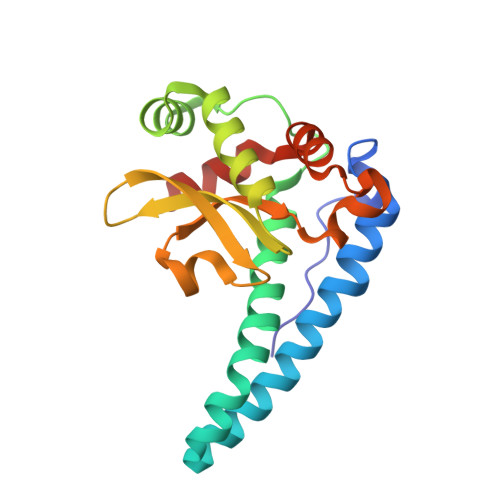Role of a glutamate bridge spanning the dimeric interface of human manganese superoxide dismutase.
Quint, P.S., Domsic, J.F., Cabelli, D.E., McKenna, R., Silverman, D.N.(2008) Biochemistry 47: 4621-4628
- PubMed: 18373354
- DOI: https://doi.org/10.1021/bi7024518
- Primary Citation of Related Structures:
3C3S, 3C3T - PubMed Abstract:
The function in the structure, stability, and catalysis of the interfaces between subunits in manganese superoxide dismutase (MnSOD) is currently under scrutiny. Glu162 in homotetrameric human MnSOD spans a dimeric interface and forms a hydrogen bond with His163 of an adjacent subunit which is a direct ligand of the manganese. We have examined the properties of two site-specific mutants of human MnSOD in which Glu162 is replaced with Asp (E162D) and Ala (E162A). The X-ray crystal structures of E162D and E162A MnSOD reveal no significant structural changes compared with the wild type other than the removal of the hydrogen bond interaction with His163 in E162A MnSOD. In the case of E162D MnSOD, an intervening solvent molecule fills the void created by the mutation to conserve the hydrogen bond interaction between His163 and residue 162. These mutants retain their tetrameric structure and their specificity for manganese over iron. Each has catalytic activity in the disproportionation of superoxide that is typically 5-25% of that of the wild-type enzyme and a level of product inhibition greater by approximately 2-fold. Differential scanning calorimetry indicates that the hydrogen bond between Glu162 and His163 contributes to the stability of MnSOD, with the major unfolding transition occurring at 81 degrees C for E162A compared to 90 degrees C for wild-type MnSOD. These results suggest that Glu162 at the tetrameric interface in human MnSOD supports stability and efficient catalysis and has a significant role in regulating product inhibition.
- Department of Pharmacology and Therapeutics, University of Florida, Gainesville, FL 32610, USA.
Organizational Affiliation:


















